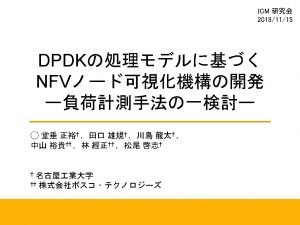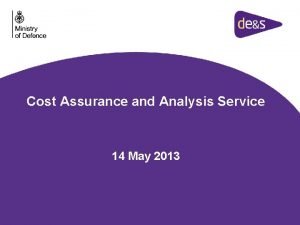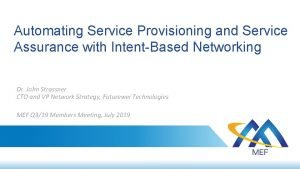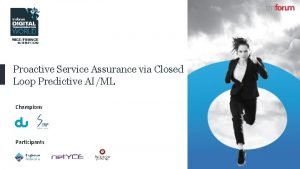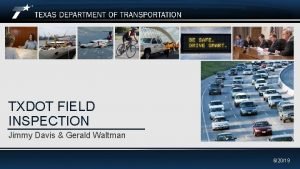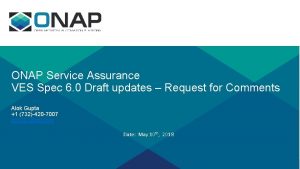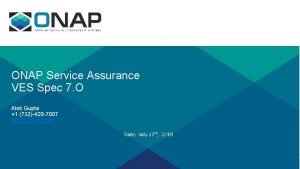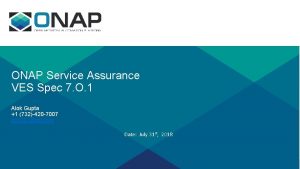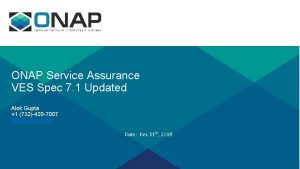ONAP Service Assurance VES Spec 6 0 Draft






- Slides: 6

ONAP Service Assurance VES Spec 6. 0 Draft updates – Request for Comments Alok Gupta +1 (732)-420 -7007 ag 1367@att. com Date: May 10 th, 2018

VES (NF Event Streaming) Specification 6. 0 Changes § Section 1 o VES Meaning: Expanded to include event streaming for VNF, PNF and Infrstrcutre o event. Names Construction: {Domain. Abbreviation}_{vnf/vnfc. Naimg. Code}_{Description. Of. Info. Being. Conveyed} o Added a list of all the latest field block version numbers in this version of the API spec. § Section 3 § Removed Throttling requirements. App-C or controller need to support thortlling. § Section 4 Future Current §§ Different hash. Maps. Changed name-value pair structures to hash. Maps § Common predictable, flexible, reusable event format interfaces and formatsall requiring for all VFs => Closed Loop Automation customization to 6 months development) § Name=(3“name”’ value =“value” => “name” = “Value” § Defined by AT&T based on conformance to standards § Defined by vendors §§ Varies Use by of network Optional fields: If the event publisher collects a field thatand is identified § Vendor agnostic Configurable as optional in functions and software releases data structures below, then the event publisher must send that field. 2 § the Extensible Filed Use Clarification: VES contains various extensible structures (e. g. , hash. Map) that enable event publishers to send information that has not been explicitly defined in VES data structures. § § Event publishers must not send information through extensible structures where VES has explicitly defined fields for that information. For example, event publishers must not send information like cpu. Idle, through an extensible structure, because VES has explicitly defined a cpu. Usage. cpu. Idle field for the communication of that information. Keys sent through extensible fields must use camel casing to separate words and acronyms; only the first letter of each acronym shall be capitalized. © 2017 AT&T Intellectual Property. All rights reserved. AT&T and the AT&T logo are trademarks of AT&T Intellectual Property. .

VES (NF Event Streaming) Specification 6. 0 Changes § Section 4 – Contd § § 3 Common Event Data Types: Changed vendor. Vnf. Name. Fields to vendor. Nf. Name. Fields in Sip. Signaling and Voice Quality Domains Common Event Header clarified the following descriptions: § event. Id: Event key that is unique to the event source. The key must be unique within notification life cycle similar to Event. ID from 3 GPP. It could be a sequential number, or a composite key formed from the event fields, such as source. Name_alarm. Condition_start. Epoch. The event. Id should not include whitespace. For fault events, event. Id is the event. Id of the initial alarm; if the same alarm is raised again for changed, acknowledged or cleared cases, event. Id must be the same as the initial alarm (along with the same start. Epoch. Microsec and an incremental sequence number). § reporting. Entity. Name: in another vnf/vm or pnf which is Future Current Name of the entity reporting the event or detecting a problem experiencing the problem. May be the same as the source. Name. For synthetic events generated by DCAE, it is the name § Common predictable, flexible, reusable event format § Different and formats of interfaces the app generating therequiring event. forwhich all VFsmay => Closed Loop Automation customization (3 to 6 months development) § source. Name: Name of the entity experiencing the event issue, be detected and reported by a separate Defined based. Aon conformance to standards § Definedreporting by vendors entity. The source. Name identifies the device for §which databy is AT&T collected. valid source. Name must be inventoried in A&AI. and If source. Name is a VNFC or VM, then§ the eventagnostic must beand reporting data for that particular VNFC or Vendor Configurable § Varies by network functions software releases VM. If the source. Name is a VNF, comprised of multiple VNFCs, the data must be reported/aggregated at the VNF leve. I. Data for individual VNFC must not be included in the VNF source. Name event. § start. Epoch. Microseconds: the earliest unix time aka epoch time associated with the event from any component--as microseconds elapsed since 1 Jan 1970 not including leap seconds. For measurements and heartbeats, where events are collected over predefined intervals, start. Epoch. Microsec shall be rounded to the nearest interval boundary (e. g. , the epoch equivalent of 3: 00 PM, 3: 10 PM, 3: 20 PM, etc…). For fault events, start. Epoch. Microsec is the timestamp of the initial alarm; if the same alarm is raised again for changed, acknowledged or cleared cases, start. Epoch Microsec must be the same as the initial alarm (along with the same event. Id an incremental sequence number). § added ‘notification and pnf. Registrion domains § Fault Domain Section 4. 2. 1: clarified the definitions of alarm. Condition and specific. Problem © 2017 AT&T Intellectual Property. All rights reserved. AT&T and the AT&T logo are trademarks of AT&T Intellectual Property. .

VES (NF Event Streaming) Specification 6. 0 Changes § Section 4 – Contd § Fault Domain: clarified the following definitions § § § 4 § alarm. Condition: Short name of the alarm condition/problem, such as a trap name. Should not have white space (e. g. , tp. Lg. Cgi. Not. In. Config, Bfd. Session. Down, link. Down, etc…) § specific. Problem: Description of the alarm or problem (e. g. , ‘This event is sent when the LG is asked to perform a location for a CGI that is not in its configuration’) Measurements. Current Domain: changed the name of this domain from ‘measurements. For. Vf. Scaling’ to Future ‘measurement’ § Common predictable, flexible, reusable event format Different interfaces and formats requiring for all VFs => Closed Loop Automation customization (3 to 6 Domain: months development) Measurement Updates following fileds: cpu. Usage, disk. Usage, memory. Usage, § Defined by AT&T based on conformance to standards Defined by vendors v. Nic. Performance to nic. Performance and added load Array, huge. Pages. Array, § Vendor agnostic and Configurable Varies by network functions and software releases Add Notification and pnf. Registrion fields § Section 6: specified message size limit of 2 Meg Note: The Excel file has IPMI metrics in the measurement domain, which will be added to the VES Listener Requirement 6. 0 and JSON Schema in the final update. © 2017 AT&T Intellectual Property. All rights reserved. AT&T and the AT&T logo are trademarks of AT&T Intellectual Property. .

VES Event Registration Specification 2. 0 Changes § Updated examples to align with VES Event Listener 6. 0 § Clarified Action keyword § Modified the rules example to conform to the Complex Conditions and Rules sections. Current § Different interfaces and formats requiring customization (3 to 6 months development) § Defined by vendors § Varies by network functions and software releases Future § Common predictable, flexible, reusable event format for all VFs => Closed Loop Automation § Defined by AT&T based on conformance to standards § Vendor agnostic and Configurable 5 © 2017 AT&T Intellectual Property. All rights reserved. AT&T and the AT&T logo are trademarks of AT&T Intellectual Property. .

Requirements Files q VES Listener Requirements 6. 0 Draft q VES JSON Schema 29. 0 draft q VES Event Registration 2. 0 Draft q VES Excel 29. 0 6 © 2017 AT&T Intellectual Property. All rights reserved. AT&T and the AT&T logo are trademarks of AT&T Intellectual Property. .
